Business Law Report: Sales, Credit, Agency, and Intellectual Property
VerifiedAdded on 2020/01/28
|17
|5192
|52
Report
AI Summary
This business law assignment report provides a comprehensive overview of several key areas within UK business law. It begins with an analysis of the Sales of Goods Act 1979, examining implied terms, statutory provisions related to the transfer of property, seller and buyer remedies, and liability for faulty goods. The report then delves into credit agreements, exploring different types, legal rules on termination of rights, and the rights and duties of parties involved. Furthermore, it examines agency law, covering the features and types of agents, along with their respective rights and duties. The report also explores competition law, addressing monopolies, anti-competitive practices, the role of the competition commission, and dominant positions in the EU market, including exemptions. Finally, the assignment concludes with an examination of intellectual property, including different forms of protection (patents, copyright, and trademarks) and the principles governing their protection, comparing trademark and business name protection.
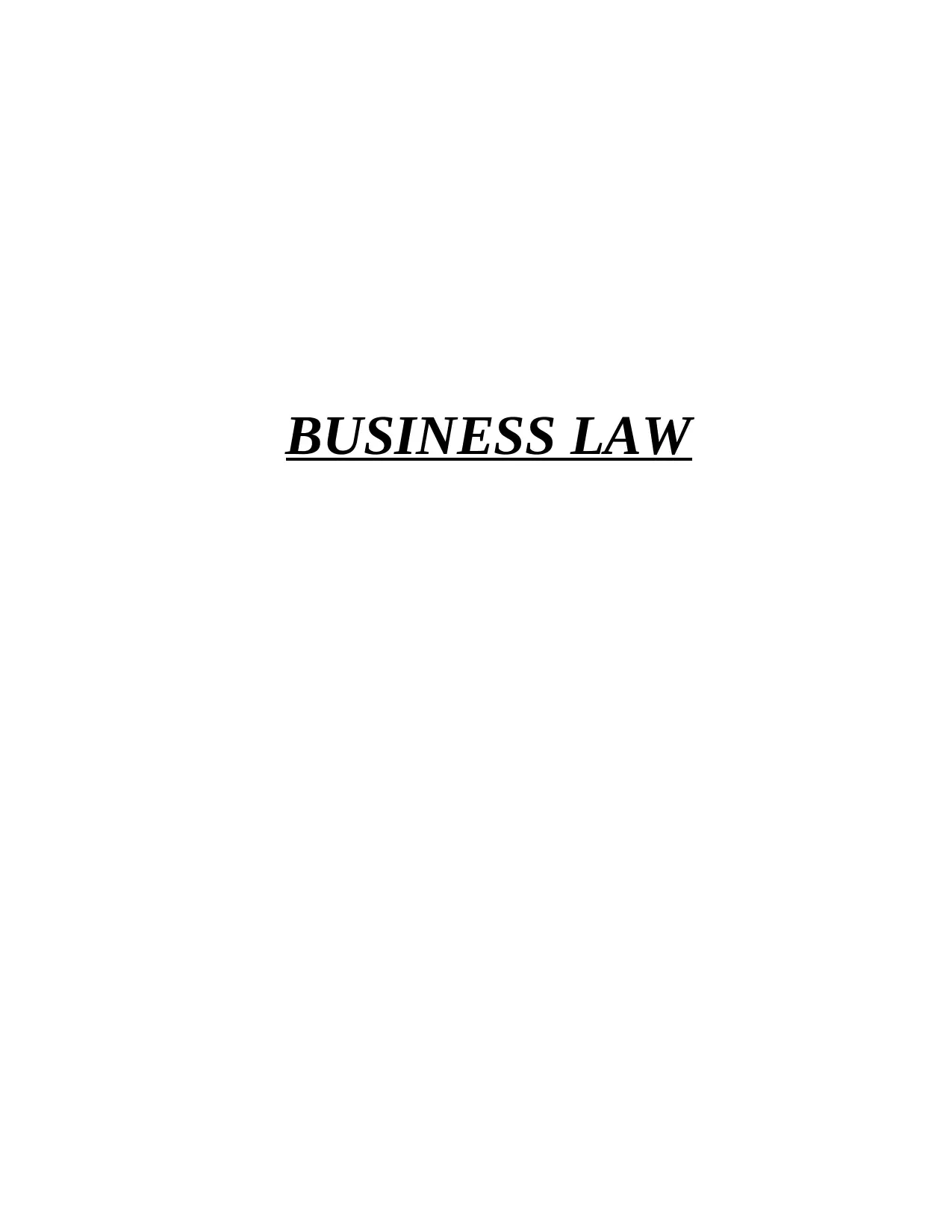
BUSINESS LAW
Paraphrase This Document
Need a fresh take? Get an instant paraphrase of this document with our AI Paraphraser
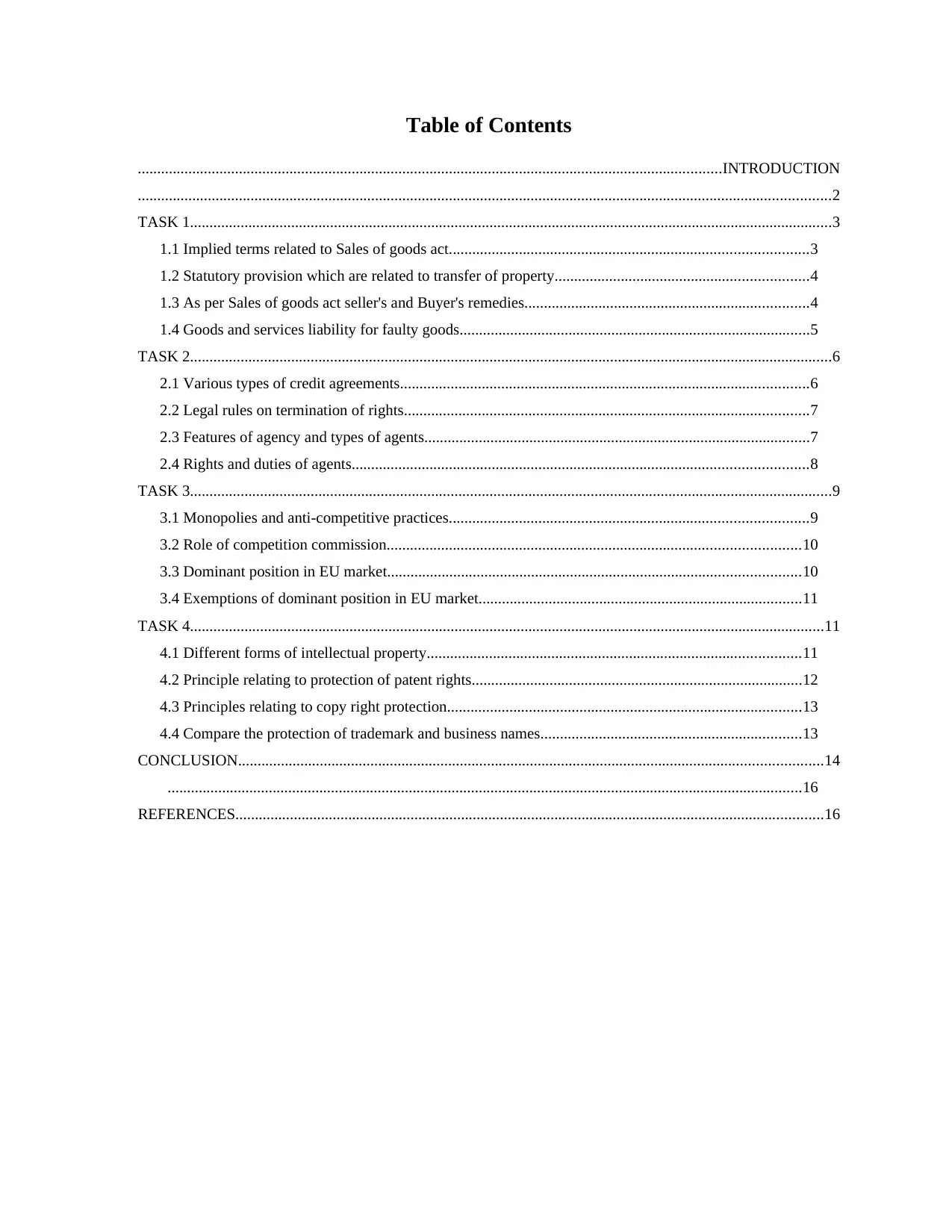
Table of Contents
......................................................................................................................................................INTRODUCTION
..................................................................................................................................................................................2
TASK 1.....................................................................................................................................................................3
1.1 Implied terms related to Sales of goods act............................................................................................3
1.2 Statutory provision which are related to transfer of property.................................................................4
1.3 As per Sales of goods act seller's and Buyer's remedies.........................................................................4
1.4 Goods and services liability for faulty goods..........................................................................................5
TASK 2.....................................................................................................................................................................6
2.1 Various types of credit agreements.........................................................................................................6
2.2 Legal rules on termination of rights........................................................................................................7
2.3 Features of agency and types of agents...................................................................................................7
2.4 Rights and duties of agents.....................................................................................................................8
TASK 3.....................................................................................................................................................................9
3.1 Monopolies and anti-competitive practices............................................................................................9
3.2 Role of competition commission..........................................................................................................10
3.3 Dominant position in EU market..........................................................................................................10
3.4 Exemptions of dominant position in EU market...................................................................................11
TASK 4...................................................................................................................................................................11
4.1 Different forms of intellectual property................................................................................................11
4.2 Principle relating to protection of patent rights.....................................................................................12
4.3 Principles relating to copy right protection...........................................................................................13
4.4 Compare the protection of trademark and business names...................................................................13
CONCLUSION......................................................................................................................................................14
...................................................................................................................................................................16
REFERENCES.......................................................................................................................................................16
......................................................................................................................................................INTRODUCTION
..................................................................................................................................................................................2
TASK 1.....................................................................................................................................................................3
1.1 Implied terms related to Sales of goods act............................................................................................3
1.2 Statutory provision which are related to transfer of property.................................................................4
1.3 As per Sales of goods act seller's and Buyer's remedies.........................................................................4
1.4 Goods and services liability for faulty goods..........................................................................................5
TASK 2.....................................................................................................................................................................6
2.1 Various types of credit agreements.........................................................................................................6
2.2 Legal rules on termination of rights........................................................................................................7
2.3 Features of agency and types of agents...................................................................................................7
2.4 Rights and duties of agents.....................................................................................................................8
TASK 3.....................................................................................................................................................................9
3.1 Monopolies and anti-competitive practices............................................................................................9
3.2 Role of competition commission..........................................................................................................10
3.3 Dominant position in EU market..........................................................................................................10
3.4 Exemptions of dominant position in EU market...................................................................................11
TASK 4...................................................................................................................................................................11
4.1 Different forms of intellectual property................................................................................................11
4.2 Principle relating to protection of patent rights.....................................................................................12
4.3 Principles relating to copy right protection...........................................................................................13
4.4 Compare the protection of trademark and business names...................................................................13
CONCLUSION......................................................................................................................................................14
...................................................................................................................................................................16
REFERENCES.......................................................................................................................................................16
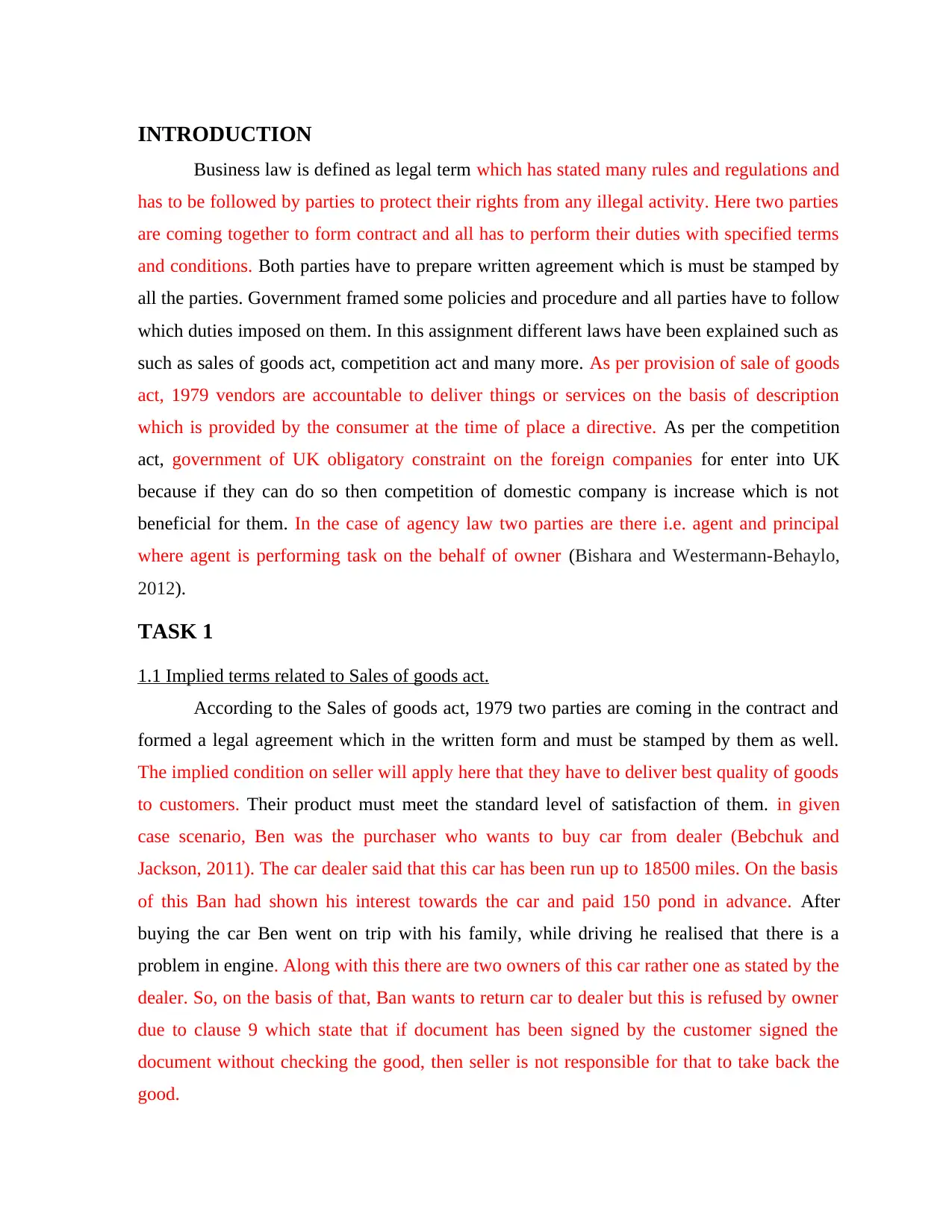
INTRODUCTION
Business law is defined as legal term which has stated many rules and regulations and
has to be followed by parties to protect their rights from any illegal activity. Here two parties
are coming together to form contract and all has to perform their duties with specified terms
and conditions. Both parties have to prepare written agreement which is must be stamped by
all the parties. Government framed some policies and procedure and all parties have to follow
which duties imposed on them. In this assignment different laws have been explained such as
such as sales of goods act, competition act and many more. As per provision of sale of goods
act, 1979 vendors are accountable to deliver things or services on the basis of description
which is provided by the consumer at the time of place a directive. As per the competition
act, government of UK obligatory constraint on the foreign companies for enter into UK
because if they can do so then competition of domestic company is increase which is not
beneficial for them. In the case of agency law two parties are there i.e. agent and principal
where agent is performing task on the behalf of owner (Bishara and Westermann‐Behaylo,
2012).
TASK 1
1.1 Implied terms related to Sales of goods act.
According to the Sales of goods act, 1979 two parties are coming in the contract and
formed a legal agreement which in the written form and must be stamped by them as well.
The implied condition on seller will apply here that they have to deliver best quality of goods
to customers. Their product must meet the standard level of satisfaction of them. in given
case scenario, Ben was the purchaser who wants to buy car from dealer (Bebchuk and
Jackson, 2011). The car dealer said that this car has been run up to 18500 miles. On the basis
of this Ban had shown his interest towards the car and paid 150 pond in advance. After
buying the car Ben went on trip with his family, while driving he realised that there is a
problem in engine. Along with this there are two owners of this car rather one as stated by the
dealer. So, on the basis of that, Ban wants to return car to dealer but this is refused by owner
due to clause 9 which state that if document has been signed by the customer signed the
document without checking the good, then seller is not responsible for that to take back the
good.
Business law is defined as legal term which has stated many rules and regulations and
has to be followed by parties to protect their rights from any illegal activity. Here two parties
are coming together to form contract and all has to perform their duties with specified terms
and conditions. Both parties have to prepare written agreement which is must be stamped by
all the parties. Government framed some policies and procedure and all parties have to follow
which duties imposed on them. In this assignment different laws have been explained such as
such as sales of goods act, competition act and many more. As per provision of sale of goods
act, 1979 vendors are accountable to deliver things or services on the basis of description
which is provided by the consumer at the time of place a directive. As per the competition
act, government of UK obligatory constraint on the foreign companies for enter into UK
because if they can do so then competition of domestic company is increase which is not
beneficial for them. In the case of agency law two parties are there i.e. agent and principal
where agent is performing task on the behalf of owner (Bishara and Westermann‐Behaylo,
2012).
TASK 1
1.1 Implied terms related to Sales of goods act.
According to the Sales of goods act, 1979 two parties are coming in the contract and
formed a legal agreement which in the written form and must be stamped by them as well.
The implied condition on seller will apply here that they have to deliver best quality of goods
to customers. Their product must meet the standard level of satisfaction of them. in given
case scenario, Ben was the purchaser who wants to buy car from dealer (Bebchuk and
Jackson, 2011). The car dealer said that this car has been run up to 18500 miles. On the basis
of this Ban had shown his interest towards the car and paid 150 pond in advance. After
buying the car Ben went on trip with his family, while driving he realised that there is a
problem in engine. Along with this there are two owners of this car rather one as stated by the
dealer. So, on the basis of that, Ban wants to return car to dealer but this is refused by owner
due to clause 9 which state that if document has been signed by the customer signed the
document without checking the good, then seller is not responsible for that to take back the
good.
⊘ This is a preview!⊘
Do you want full access?
Subscribe today to unlock all pages.

Trusted by 1+ million students worldwide
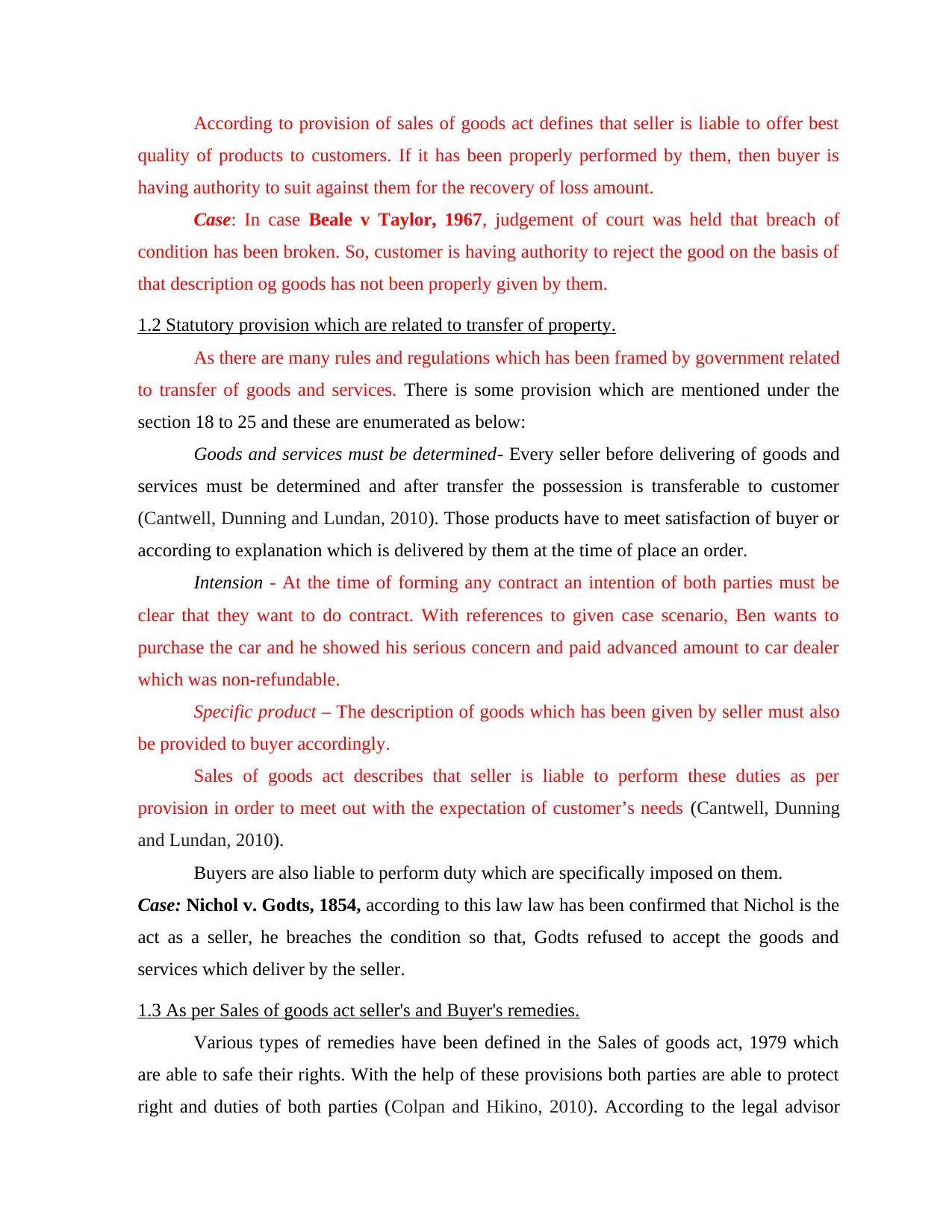
According to provision of sales of goods act defines that seller is liable to offer best
quality of products to customers. If it has been properly performed by them, then buyer is
having authority to suit against them for the recovery of loss amount.
Case: In case Beale v Taylor, 1967, judgement of court was held that breach of
condition has been broken. So, customer is having authority to reject the good on the basis of
that description og goods has not been properly given by them.
1.2 Statutory provision which are related to transfer of property.
As there are many rules and regulations which has been framed by government related
to transfer of goods and services. There is some provision which are mentioned under the
section 18 to 25 and these are enumerated as below:
Goods and services must be determined- Every seller before delivering of goods and
services must be determined and after transfer the possession is transferable to customer
(Cantwell, Dunning and Lundan, 2010). Those products have to meet satisfaction of buyer or
according to explanation which is delivered by them at the time of place an order.
Intension - At the time of forming any contract an intention of both parties must be
clear that they want to do contract. With references to given case scenario, Ben wants to
purchase the car and he showed his serious concern and paid advanced amount to car dealer
which was non-refundable.
Specific product – The description of goods which has been given by seller must also
be provided to buyer accordingly.
Sales of goods act describes that seller is liable to perform these duties as per
provision in order to meet out with the expectation of customer’s needs (Cantwell, Dunning
and Lundan, 2010).
Buyers are also liable to perform duty which are specifically imposed on them.
Case: Nichol v. Godts, 1854, according to this law law has been confirmed that Nichol is the
act as a seller, he breaches the condition so that, Godts refused to accept the goods and
services which deliver by the seller.
1.3 As per Sales of goods act seller's and Buyer's remedies.
Various types of remedies have been defined in the Sales of goods act, 1979 which
are able to safe their rights. With the help of these provisions both parties are able to protect
right and duties of both parties (Colpan and Hikino, 2010). According to the legal advisor
quality of products to customers. If it has been properly performed by them, then buyer is
having authority to suit against them for the recovery of loss amount.
Case: In case Beale v Taylor, 1967, judgement of court was held that breach of
condition has been broken. So, customer is having authority to reject the good on the basis of
that description og goods has not been properly given by them.
1.2 Statutory provision which are related to transfer of property.
As there are many rules and regulations which has been framed by government related
to transfer of goods and services. There is some provision which are mentioned under the
section 18 to 25 and these are enumerated as below:
Goods and services must be determined- Every seller before delivering of goods and
services must be determined and after transfer the possession is transferable to customer
(Cantwell, Dunning and Lundan, 2010). Those products have to meet satisfaction of buyer or
according to explanation which is delivered by them at the time of place an order.
Intension - At the time of forming any contract an intention of both parties must be
clear that they want to do contract. With references to given case scenario, Ben wants to
purchase the car and he showed his serious concern and paid advanced amount to car dealer
which was non-refundable.
Specific product – The description of goods which has been given by seller must also
be provided to buyer accordingly.
Sales of goods act describes that seller is liable to perform these duties as per
provision in order to meet out with the expectation of customer’s needs (Cantwell, Dunning
and Lundan, 2010).
Buyers are also liable to perform duty which are specifically imposed on them.
Case: Nichol v. Godts, 1854, according to this law law has been confirmed that Nichol is the
act as a seller, he breaches the condition so that, Godts refused to accept the goods and
services which deliver by the seller.
1.3 As per Sales of goods act seller's and Buyer's remedies.
Various types of remedies have been defined in the Sales of goods act, 1979 which
are able to safe their rights. With the help of these provisions both parties are able to protect
right and duties of both parties (Colpan and Hikino, 2010). According to the legal advisor
Paraphrase This Document
Need a fresh take? Get an instant paraphrase of this document with our AI Paraphraser
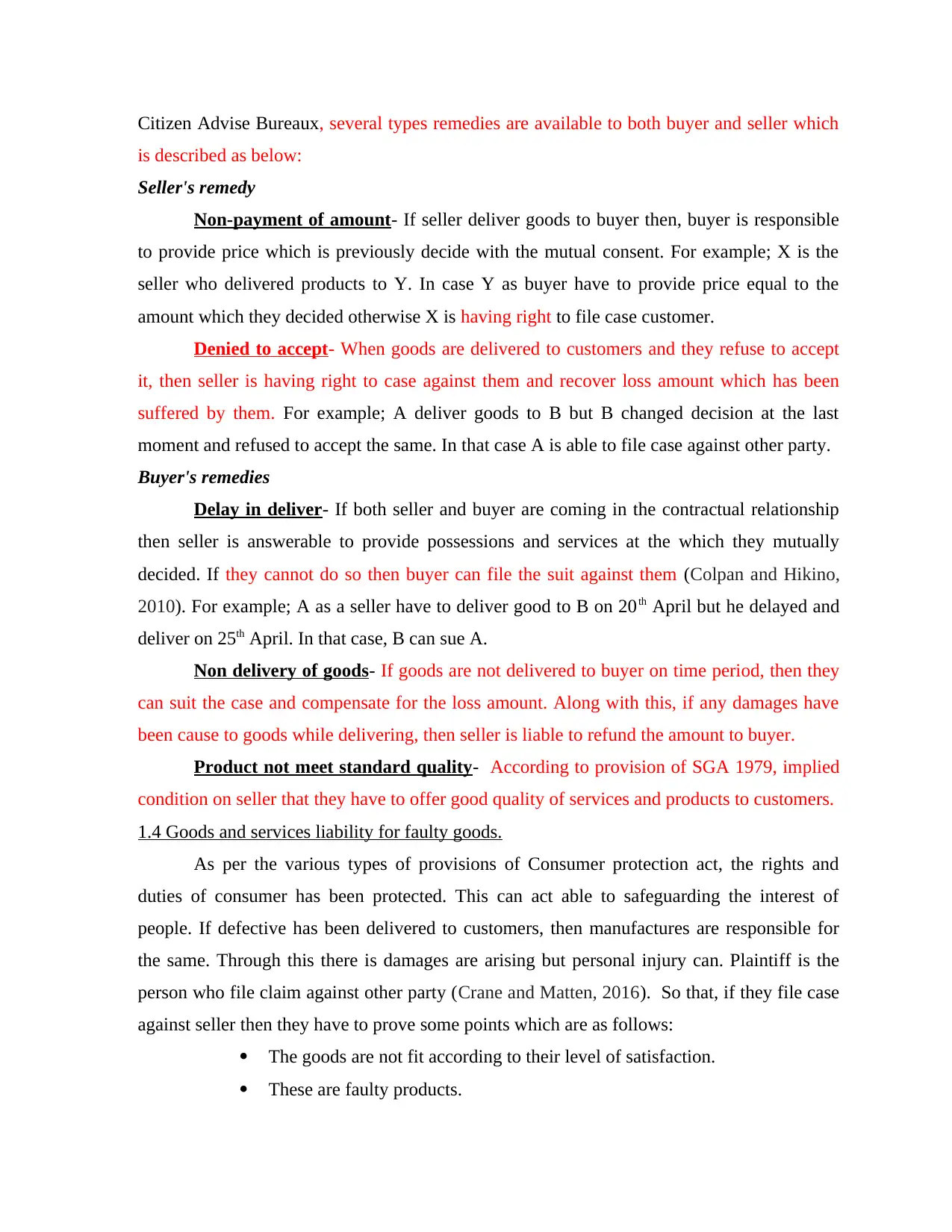
Citizen Advise Bureaux, several types remedies are available to both buyer and seller which
is described as below:
Seller's remedy
Non-payment of amount- If seller deliver goods to buyer then, buyer is responsible
to provide price which is previously decide with the mutual consent. For example; X is the
seller who delivered products to Y. In case Y as buyer have to provide price equal to the
amount which they decided otherwise X is having right to file case customer.
Denied to accept- When goods are delivered to customers and they refuse to accept
it, then seller is having right to case against them and recover loss amount which has been
suffered by them. For example; A deliver goods to B but B changed decision at the last
moment and refused to accept the same. In that case A is able to file case against other party.
Buyer's remedies
Delay in deliver- If both seller and buyer are coming in the contractual relationship
then seller is answerable to provide possessions and services at the which they mutually
decided. If they cannot do so then buyer can file the suit against them (Colpan and Hikino,
2010). For example; A as a seller have to deliver good to B on 20th April but he delayed and
deliver on 25th April. In that case, B can sue A.
Non delivery of goods- If goods are not delivered to buyer on time period, then they
can suit the case and compensate for the loss amount. Along with this, if any damages have
been cause to goods while delivering, then seller is liable to refund the amount to buyer.
Product not meet standard quality- According to provision of SGA 1979, implied
condition on seller that they have to offer good quality of services and products to customers.
1.4 Goods and services liability for faulty goods.
As per the various types of provisions of Consumer protection act, the rights and
duties of consumer has been protected. This can act able to safeguarding the interest of
people. If defective has been delivered to customers, then manufactures are responsible for
the same. Through this there is damages are arising but personal injury can. Plaintiff is the
person who file claim against other party (Crane and Matten, 2016). So that, if they file case
against seller then they have to prove some points which are as follows:
The goods are not fit according to their level of satisfaction.
These are faulty products.
is described as below:
Seller's remedy
Non-payment of amount- If seller deliver goods to buyer then, buyer is responsible
to provide price which is previously decide with the mutual consent. For example; X is the
seller who delivered products to Y. In case Y as buyer have to provide price equal to the
amount which they decided otherwise X is having right to file case customer.
Denied to accept- When goods are delivered to customers and they refuse to accept
it, then seller is having right to case against them and recover loss amount which has been
suffered by them. For example; A deliver goods to B but B changed decision at the last
moment and refused to accept the same. In that case A is able to file case against other party.
Buyer's remedies
Delay in deliver- If both seller and buyer are coming in the contractual relationship
then seller is answerable to provide possessions and services at the which they mutually
decided. If they cannot do so then buyer can file the suit against them (Colpan and Hikino,
2010). For example; A as a seller have to deliver good to B on 20th April but he delayed and
deliver on 25th April. In that case, B can sue A.
Non delivery of goods- If goods are not delivered to buyer on time period, then they
can suit the case and compensate for the loss amount. Along with this, if any damages have
been cause to goods while delivering, then seller is liable to refund the amount to buyer.
Product not meet standard quality- According to provision of SGA 1979, implied
condition on seller that they have to offer good quality of services and products to customers.
1.4 Goods and services liability for faulty goods.
As per the various types of provisions of Consumer protection act, the rights and
duties of consumer has been protected. This can act able to safeguarding the interest of
people. If defective has been delivered to customers, then manufactures are responsible for
the same. Through this there is damages are arising but personal injury can. Plaintiff is the
person who file claim against other party (Crane and Matten, 2016). So that, if they file case
against seller then they have to prove some points which are as follows:
The goods are not fit according to their level of satisfaction.
These are faulty products.
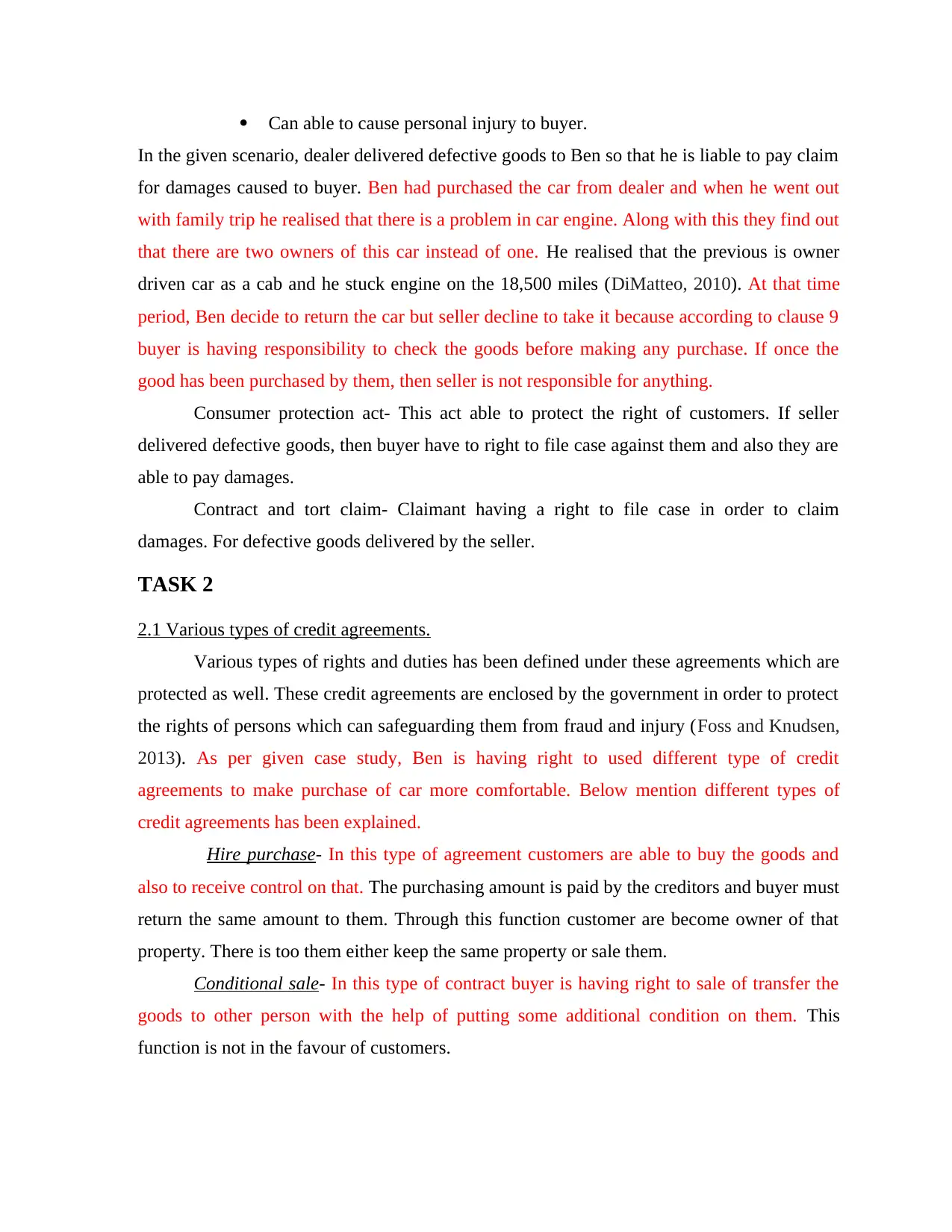
Can able to cause personal injury to buyer.
In the given scenario, dealer delivered defective goods to Ben so that he is liable to pay claim
for damages caused to buyer. Ben had purchased the car from dealer and when he went out
with family trip he realised that there is a problem in car engine. Along with this they find out
that there are two owners of this car instead of one. He realised that the previous is owner
driven car as a cab and he stuck engine on the 18,500 miles (DiMatteo, 2010). At that time
period, Ben decide to return the car but seller decline to take it because according to clause 9
buyer is having responsibility to check the goods before making any purchase. If once the
good has been purchased by them, then seller is not responsible for anything.
Consumer protection act- This act able to protect the right of customers. If seller
delivered defective goods, then buyer have to right to file case against them and also they are
able to pay damages.
Contract and tort claim- Claimant having a right to file case in order to claim
damages. For defective goods delivered by the seller.
TASK 2
2.1 Various types of credit agreements.
Various types of rights and duties has been defined under these agreements which are
protected as well. These credit agreements are enclosed by the government in order to protect
the rights of persons which can safeguarding them from fraud and injury (Foss and Knudsen,
2013). As per given case study, Ben is having right to used different type of credit
agreements to make purchase of car more comfortable. Below mention different types of
credit agreements has been explained.
Hire purchase- In this type of agreement customers are able to buy the goods and
also to receive control on that. The purchasing amount is paid by the creditors and buyer must
return the same amount to them. Through this function customer are become owner of that
property. There is too them either keep the same property or sale them.
Conditional sale- In this type of contract buyer is having right to sale of transfer the
goods to other person with the help of putting some additional condition on them. This
function is not in the favour of customers.
In the given scenario, dealer delivered defective goods to Ben so that he is liable to pay claim
for damages caused to buyer. Ben had purchased the car from dealer and when he went out
with family trip he realised that there is a problem in car engine. Along with this they find out
that there are two owners of this car instead of one. He realised that the previous is owner
driven car as a cab and he stuck engine on the 18,500 miles (DiMatteo, 2010). At that time
period, Ben decide to return the car but seller decline to take it because according to clause 9
buyer is having responsibility to check the goods before making any purchase. If once the
good has been purchased by them, then seller is not responsible for anything.
Consumer protection act- This act able to protect the right of customers. If seller
delivered defective goods, then buyer have to right to file case against them and also they are
able to pay damages.
Contract and tort claim- Claimant having a right to file case in order to claim
damages. For defective goods delivered by the seller.
TASK 2
2.1 Various types of credit agreements.
Various types of rights and duties has been defined under these agreements which are
protected as well. These credit agreements are enclosed by the government in order to protect
the rights of persons which can safeguarding them from fraud and injury (Foss and Knudsen,
2013). As per given case study, Ben is having right to used different type of credit
agreements to make purchase of car more comfortable. Below mention different types of
credit agreements has been explained.
Hire purchase- In this type of agreement customers are able to buy the goods and
also to receive control on that. The purchasing amount is paid by the creditors and buyer must
return the same amount to them. Through this function customer are become owner of that
property. There is too them either keep the same property or sale them.
Conditional sale- In this type of contract buyer is having right to sale of transfer the
goods to other person with the help of putting some additional condition on them. This
function is not in the favour of customers.
⊘ This is a preview!⊘
Do you want full access?
Subscribe today to unlock all pages.

Trusted by 1+ million students worldwide
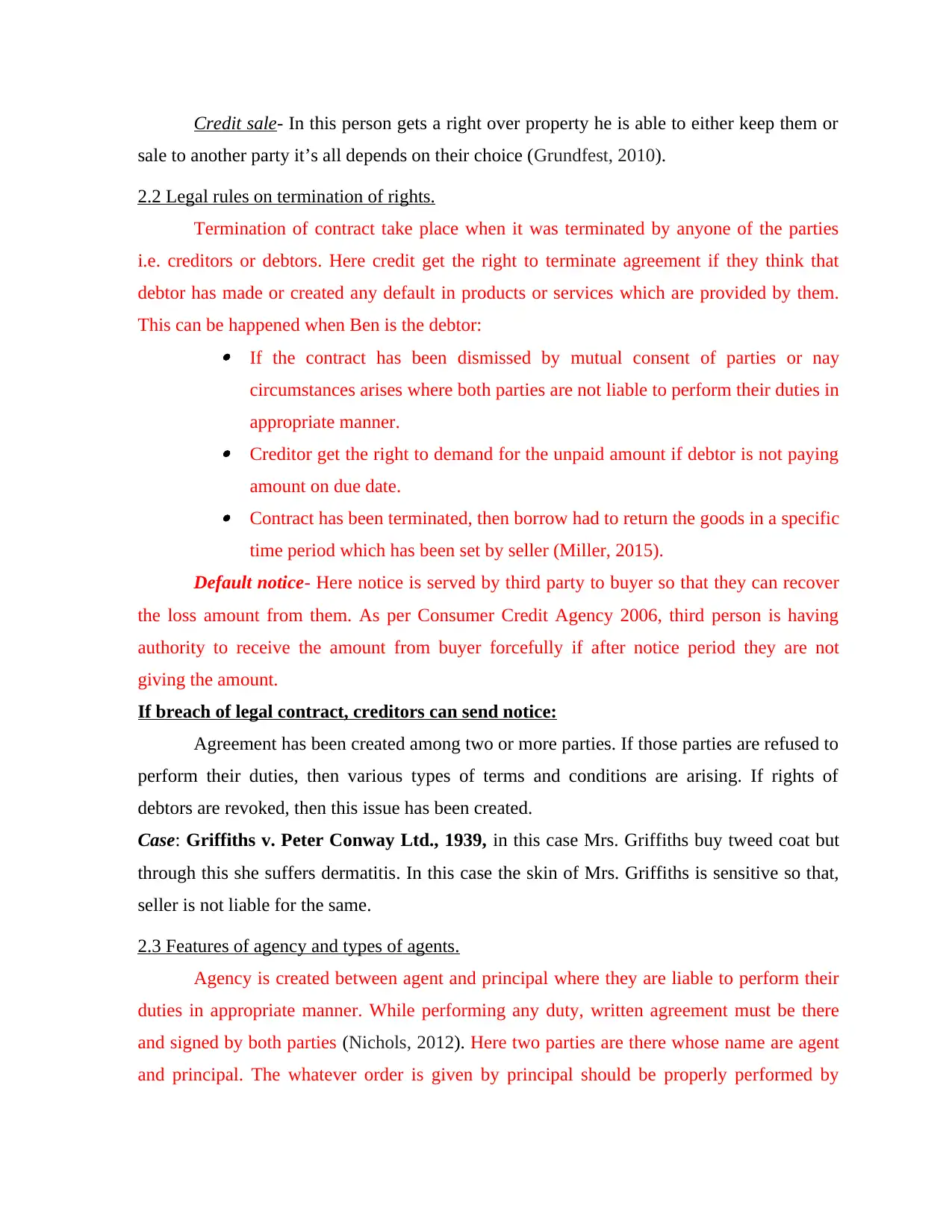
Credit sale- In this person gets a right over property he is able to either keep them or
sale to another party it’s all depends on their choice (Grundfest, 2010).
2.2 Legal rules on termination of rights.
Termination of contract take place when it was terminated by anyone of the parties
i.e. creditors or debtors. Here credit get the right to terminate agreement if they think that
debtor has made or created any default in products or services which are provided by them.
This can be happened when Ben is the debtor:
If the contract has been dismissed by mutual consent of parties or nay
circumstances arises where both parties are not liable to perform their duties in
appropriate manner.
Creditor get the right to demand for the unpaid amount if debtor is not paying
amount on due date.
Contract has been terminated, then borrow had to return the goods in a specific
time period which has been set by seller (Miller, 2015).
Default notice- Here notice is served by third party to buyer so that they can recover
the loss amount from them. As per Consumer Credit Agency 2006, third person is having
authority to receive the amount from buyer forcefully if after notice period they are not
giving the amount.
If breach of legal contract, creditors can send notice:
Agreement has been created among two or more parties. If those parties are refused to
perform their duties, then various types of terms and conditions are arising. If rights of
debtors are revoked, then this issue has been created.
Case: Griffiths v. Peter Conway Ltd., 1939, in this case Mrs. Griffiths buy tweed coat but
through this she suffers dermatitis. In this case the skin of Mrs. Griffiths is sensitive so that,
seller is not liable for the same.
2.3 Features of agency and types of agents.
Agency is created between agent and principal where they are liable to perform their
duties in appropriate manner. While performing any duty, written agreement must be there
and signed by both parties (Nichols, 2012). Here two parties are there whose name are agent
and principal. The whatever order is given by principal should be properly performed by
sale to another party it’s all depends on their choice (Grundfest, 2010).
2.2 Legal rules on termination of rights.
Termination of contract take place when it was terminated by anyone of the parties
i.e. creditors or debtors. Here credit get the right to terminate agreement if they think that
debtor has made or created any default in products or services which are provided by them.
This can be happened when Ben is the debtor:
If the contract has been dismissed by mutual consent of parties or nay
circumstances arises where both parties are not liable to perform their duties in
appropriate manner.
Creditor get the right to demand for the unpaid amount if debtor is not paying
amount on due date.
Contract has been terminated, then borrow had to return the goods in a specific
time period which has been set by seller (Miller, 2015).
Default notice- Here notice is served by third party to buyer so that they can recover
the loss amount from them. As per Consumer Credit Agency 2006, third person is having
authority to receive the amount from buyer forcefully if after notice period they are not
giving the amount.
If breach of legal contract, creditors can send notice:
Agreement has been created among two or more parties. If those parties are refused to
perform their duties, then various types of terms and conditions are arising. If rights of
debtors are revoked, then this issue has been created.
Case: Griffiths v. Peter Conway Ltd., 1939, in this case Mrs. Griffiths buy tweed coat but
through this she suffers dermatitis. In this case the skin of Mrs. Griffiths is sensitive so that,
seller is not liable for the same.
2.3 Features of agency and types of agents.
Agency is created between agent and principal where they are liable to perform their
duties in appropriate manner. While performing any duty, written agreement must be there
and signed by both parties (Nichols, 2012). Here two parties are there whose name are agent
and principal. The whatever order is given by principal should be properly performed by
Paraphrase This Document
Need a fresh take? Get an instant paraphrase of this document with our AI Paraphraser
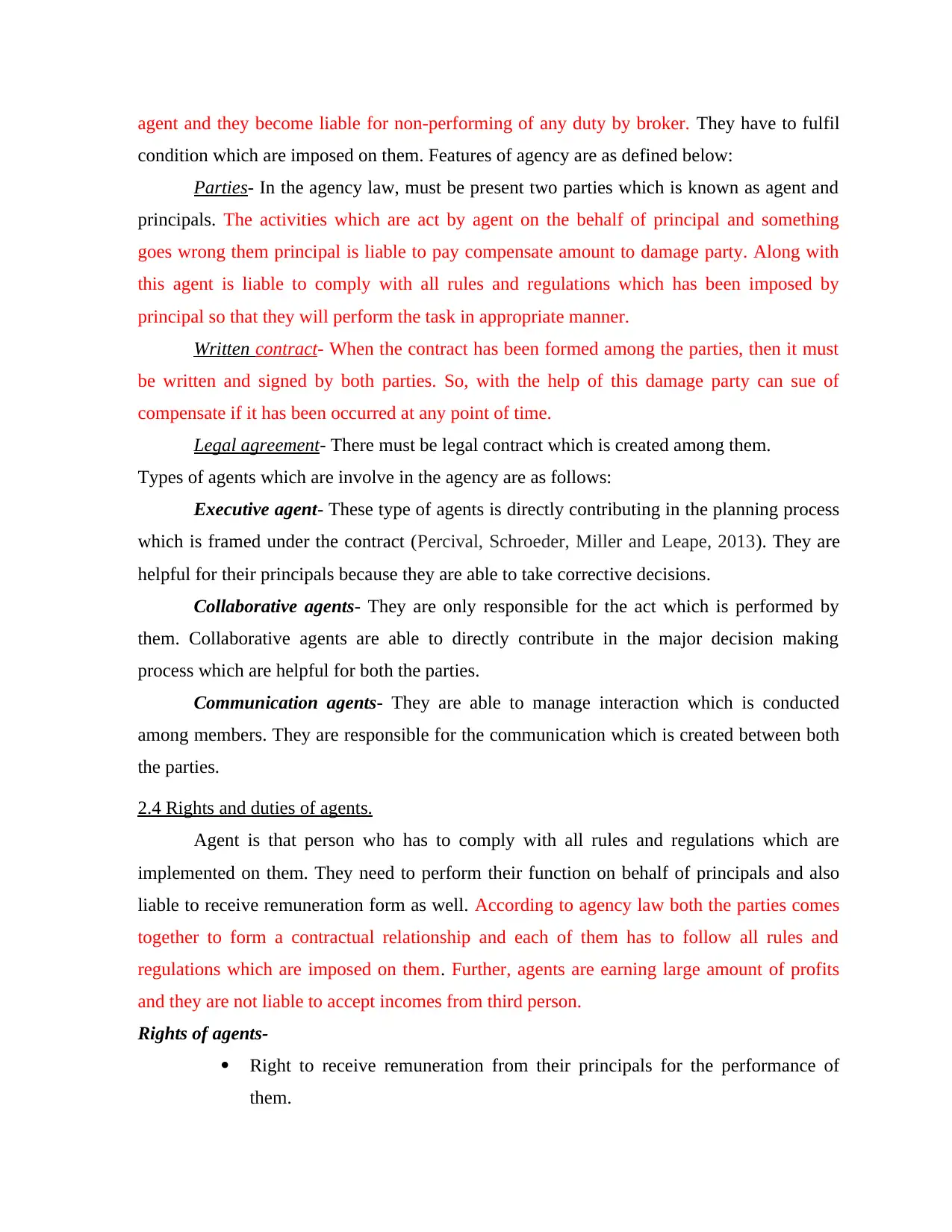
agent and they become liable for non-performing of any duty by broker. They have to fulfil
condition which are imposed on them. Features of agency are as defined below:
Parties- In the agency law, must be present two parties which is known as agent and
principals. The activities which are act by agent on the behalf of principal and something
goes wrong them principal is liable to pay compensate amount to damage party. Along with
this agent is liable to comply with all rules and regulations which has been imposed by
principal so that they will perform the task in appropriate manner.
Written contract- When the contract has been formed among the parties, then it must
be written and signed by both parties. So, with the help of this damage party can sue of
compensate if it has been occurred at any point of time.
Legal agreement- There must be legal contract which is created among them.
Types of agents which are involve in the agency are as follows:
Executive agent- These type of agents is directly contributing in the planning process
which is framed under the contract (Percival, Schroeder, Miller and Leape, 2013). They are
helpful for their principals because they are able to take corrective decisions.
Collaborative agents- They are only responsible for the act which is performed by
them. Collaborative agents are able to directly contribute in the major decision making
process which are helpful for both the parties.
Communication agents- They are able to manage interaction which is conducted
among members. They are responsible for the communication which is created between both
the parties.
2.4 Rights and duties of agents.
Agent is that person who has to comply with all rules and regulations which are
implemented on them. They need to perform their function on behalf of principals and also
liable to receive remuneration form as well. According to agency law both the parties comes
together to form a contractual relationship and each of them has to follow all rules and
regulations which are imposed on them. Further, agents are earning large amount of profits
and they are not liable to accept incomes from third person.
Rights of agents-
Right to receive remuneration from their principals for the performance of
them.
condition which are imposed on them. Features of agency are as defined below:
Parties- In the agency law, must be present two parties which is known as agent and
principals. The activities which are act by agent on the behalf of principal and something
goes wrong them principal is liable to pay compensate amount to damage party. Along with
this agent is liable to comply with all rules and regulations which has been imposed by
principal so that they will perform the task in appropriate manner.
Written contract- When the contract has been formed among the parties, then it must
be written and signed by both parties. So, with the help of this damage party can sue of
compensate if it has been occurred at any point of time.
Legal agreement- There must be legal contract which is created among them.
Types of agents which are involve in the agency are as follows:
Executive agent- These type of agents is directly contributing in the planning process
which is framed under the contract (Percival, Schroeder, Miller and Leape, 2013). They are
helpful for their principals because they are able to take corrective decisions.
Collaborative agents- They are only responsible for the act which is performed by
them. Collaborative agents are able to directly contribute in the major decision making
process which are helpful for both the parties.
Communication agents- They are able to manage interaction which is conducted
among members. They are responsible for the communication which is created between both
the parties.
2.4 Rights and duties of agents.
Agent is that person who has to comply with all rules and regulations which are
implemented on them. They need to perform their function on behalf of principals and also
liable to receive remuneration form as well. According to agency law both the parties comes
together to form a contractual relationship and each of them has to follow all rules and
regulations which are imposed on them. Further, agents are earning large amount of profits
and they are not liable to accept incomes from third person.
Rights of agents-
Right to receive remuneration from their principals for the performance of
them.
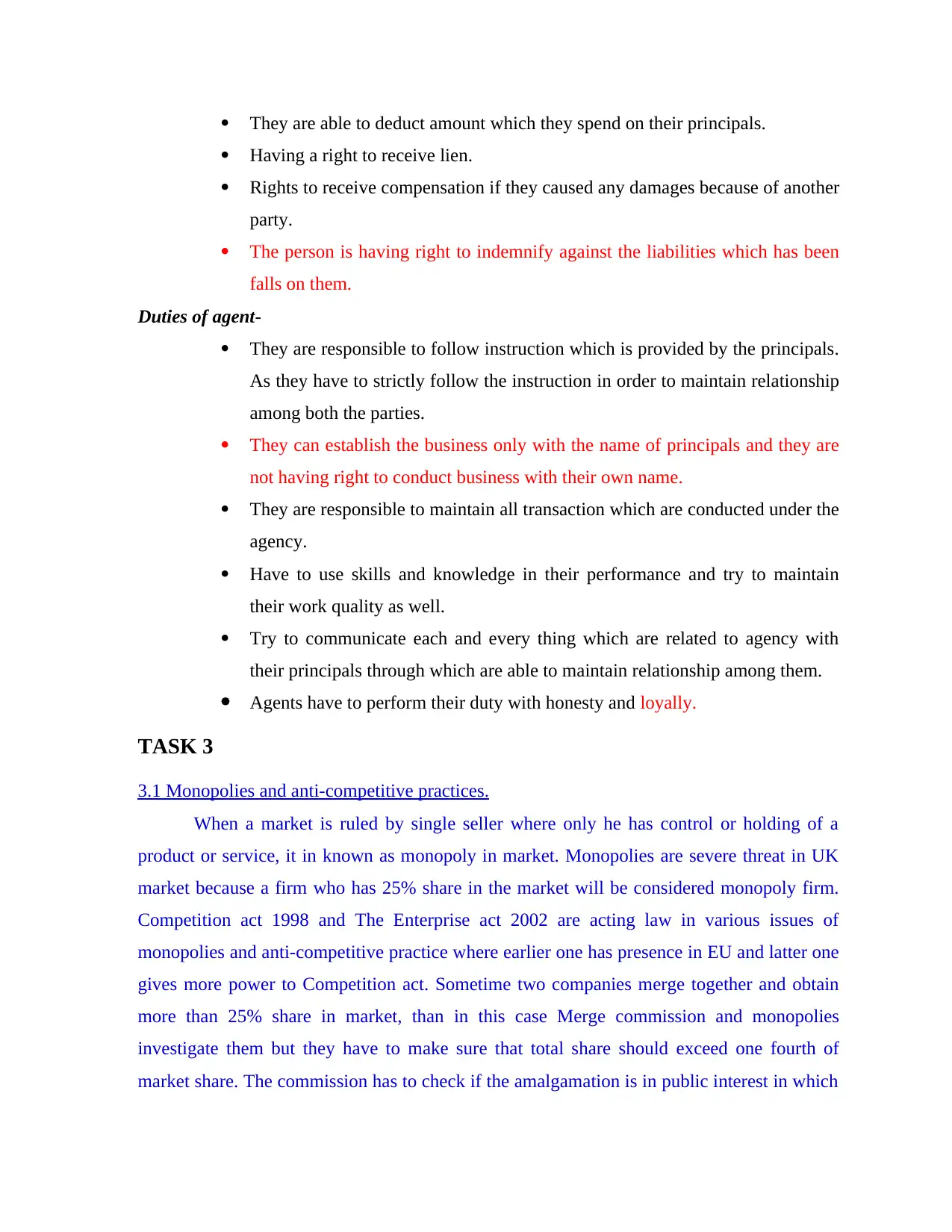
They are able to deduct amount which they spend on their principals.
Having a right to receive lien.
Rights to receive compensation if they caused any damages because of another
party.
The person is having right to indemnify against the liabilities which has been
falls on them.
Duties of agent-
They are responsible to follow instruction which is provided by the principals.
As they have to strictly follow the instruction in order to maintain relationship
among both the parties.
They can establish the business only with the name of principals and they are
not having right to conduct business with their own name.
They are responsible to maintain all transaction which are conducted under the
agency.
Have to use skills and knowledge in their performance and try to maintain
their work quality as well.
Try to communicate each and every thing which are related to agency with
their principals through which are able to maintain relationship among them.
Agents have to perform their duty with honesty and loyally.
TASK 3
3.1 Monopolies and anti-competitive practices.
When a market is ruled by single seller where only he has control or holding of a
product or service, it in known as monopoly in market. Monopolies are severe threat in UK
market because a firm who has 25% share in the market will be considered monopoly firm.
Competition act 1998 and The Enterprise act 2002 are acting law in various issues of
monopolies and anti-competitive practice where earlier one has presence in EU and latter one
gives more power to Competition act. Sometime two companies merge together and obtain
more than 25% share in market, than in this case Merge commission and monopolies
investigate them but they have to make sure that total share should exceed one fourth of
market share. The commission has to check if the amalgamation is in public interest in which
Having a right to receive lien.
Rights to receive compensation if they caused any damages because of another
party.
The person is having right to indemnify against the liabilities which has been
falls on them.
Duties of agent-
They are responsible to follow instruction which is provided by the principals.
As they have to strictly follow the instruction in order to maintain relationship
among both the parties.
They can establish the business only with the name of principals and they are
not having right to conduct business with their own name.
They are responsible to maintain all transaction which are conducted under the
agency.
Have to use skills and knowledge in their performance and try to maintain
their work quality as well.
Try to communicate each and every thing which are related to agency with
their principals through which are able to maintain relationship among them.
Agents have to perform their duty with honesty and loyally.
TASK 3
3.1 Monopolies and anti-competitive practices.
When a market is ruled by single seller where only he has control or holding of a
product or service, it in known as monopoly in market. Monopolies are severe threat in UK
market because a firm who has 25% share in the market will be considered monopoly firm.
Competition act 1998 and The Enterprise act 2002 are acting law in various issues of
monopolies and anti-competitive practice where earlier one has presence in EU and latter one
gives more power to Competition act. Sometime two companies merge together and obtain
more than 25% share in market, than in this case Merge commission and monopolies
investigate them but they have to make sure that total share should exceed one fourth of
market share. The commission has to check if the amalgamation is in public interest in which
⊘ This is a preview!⊘
Do you want full access?
Subscribe today to unlock all pages.

Trusted by 1+ million students worldwide
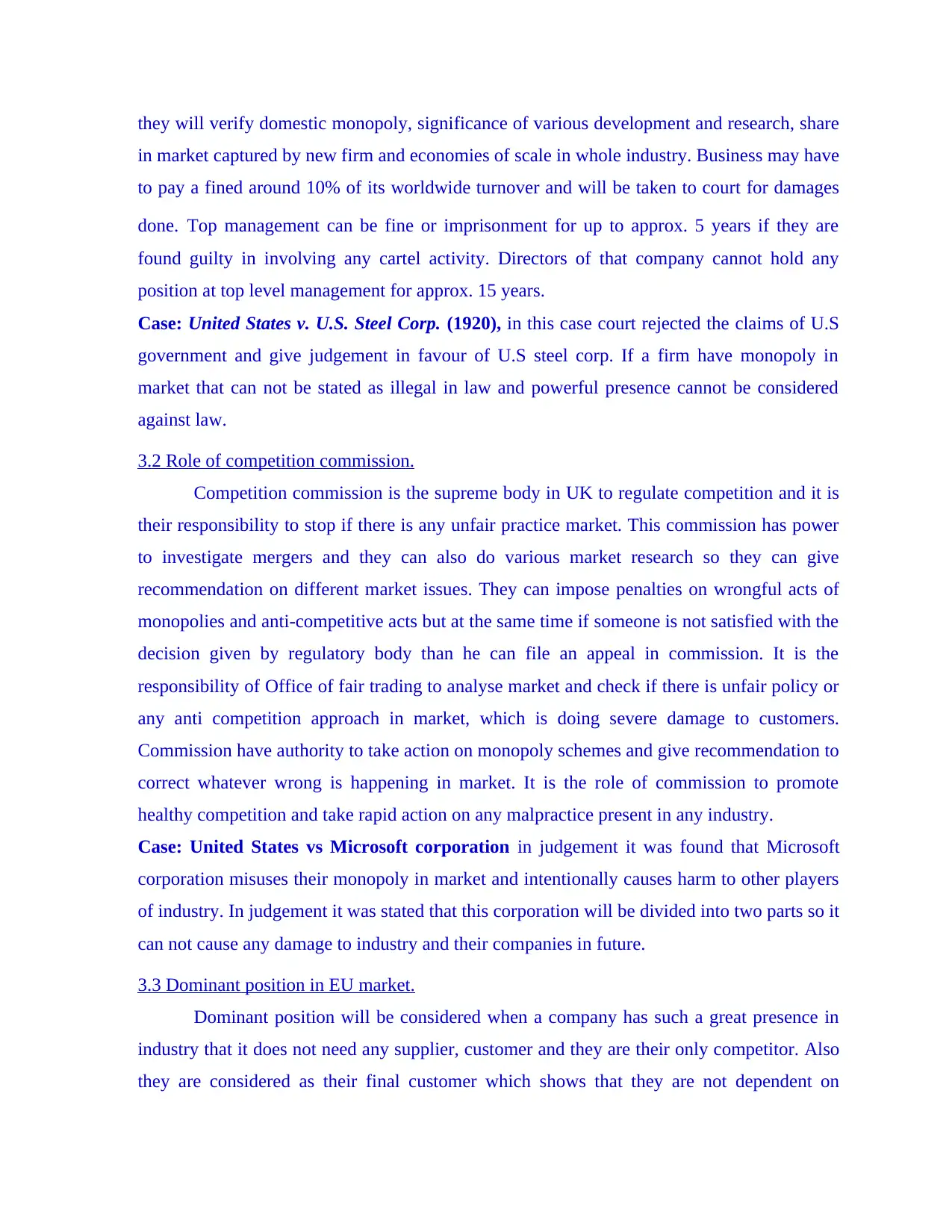
they will verify domestic monopoly, significance of various development and research, share
in market captured by new firm and economies of scale in whole industry. Business may have
to pay a fined around 10% of its worldwide turnover and will be taken to court for damages
done. Top management can be fine or imprisonment for up to approx. 5 years if they are
found guilty in involving any cartel activity. Directors of that company cannot hold any
position at top level management for approx. 15 years.
Case: United States v. U.S. Steel Corp. (1920), in this case court rejected the claims of U.S
government and give judgement in favour of U.S steel corp. If a firm have monopoly in
market that can not be stated as illegal in law and powerful presence cannot be considered
against law.
3.2 Role of competition commission.
Competition commission is the supreme body in UK to regulate competition and it is
their responsibility to stop if there is any unfair practice market. This commission has power
to investigate mergers and they can also do various market research so they can give
recommendation on different market issues. They can impose penalties on wrongful acts of
monopolies and anti-competitive acts but at the same time if someone is not satisfied with the
decision given by regulatory body than he can file an appeal in commission. It is the
responsibility of Office of fair trading to analyse market and check if there is unfair policy or
any anti competition approach in market, which is doing severe damage to customers.
Commission have authority to take action on monopoly schemes and give recommendation to
correct whatever wrong is happening in market. It is the role of commission to promote
healthy competition and take rapid action on any malpractice present in any industry.
Case: United States vs Microsoft corporation in judgement it was found that Microsoft
corporation misuses their monopoly in market and intentionally causes harm to other players
of industry. In judgement it was stated that this corporation will be divided into two parts so it
can not cause any damage to industry and their companies in future.
3.3 Dominant position in EU market.
Dominant position will be considered when a company has such a great presence in
industry that it does not need any supplier, customer and they are their only competitor. Also
they are considered as their final customer which shows that they are not dependent on
in market captured by new firm and economies of scale in whole industry. Business may have
to pay a fined around 10% of its worldwide turnover and will be taken to court for damages
done. Top management can be fine or imprisonment for up to approx. 5 years if they are
found guilty in involving any cartel activity. Directors of that company cannot hold any
position at top level management for approx. 15 years.
Case: United States v. U.S. Steel Corp. (1920), in this case court rejected the claims of U.S
government and give judgement in favour of U.S steel corp. If a firm have monopoly in
market that can not be stated as illegal in law and powerful presence cannot be considered
against law.
3.2 Role of competition commission.
Competition commission is the supreme body in UK to regulate competition and it is
their responsibility to stop if there is any unfair practice market. This commission has power
to investigate mergers and they can also do various market research so they can give
recommendation on different market issues. They can impose penalties on wrongful acts of
monopolies and anti-competitive acts but at the same time if someone is not satisfied with the
decision given by regulatory body than he can file an appeal in commission. It is the
responsibility of Office of fair trading to analyse market and check if there is unfair policy or
any anti competition approach in market, which is doing severe damage to customers.
Commission have authority to take action on monopoly schemes and give recommendation to
correct whatever wrong is happening in market. It is the role of commission to promote
healthy competition and take rapid action on any malpractice present in any industry.
Case: United States vs Microsoft corporation in judgement it was found that Microsoft
corporation misuses their monopoly in market and intentionally causes harm to other players
of industry. In judgement it was stated that this corporation will be divided into two parts so it
can not cause any damage to industry and their companies in future.
3.3 Dominant position in EU market.
Dominant position will be considered when a company has such a great presence in
industry that it does not need any supplier, customer and they are their only competitor. Also
they are considered as their final customer which shows that they are not dependent on
Paraphrase This Document
Need a fresh take? Get an instant paraphrase of this document with our AI Paraphraser
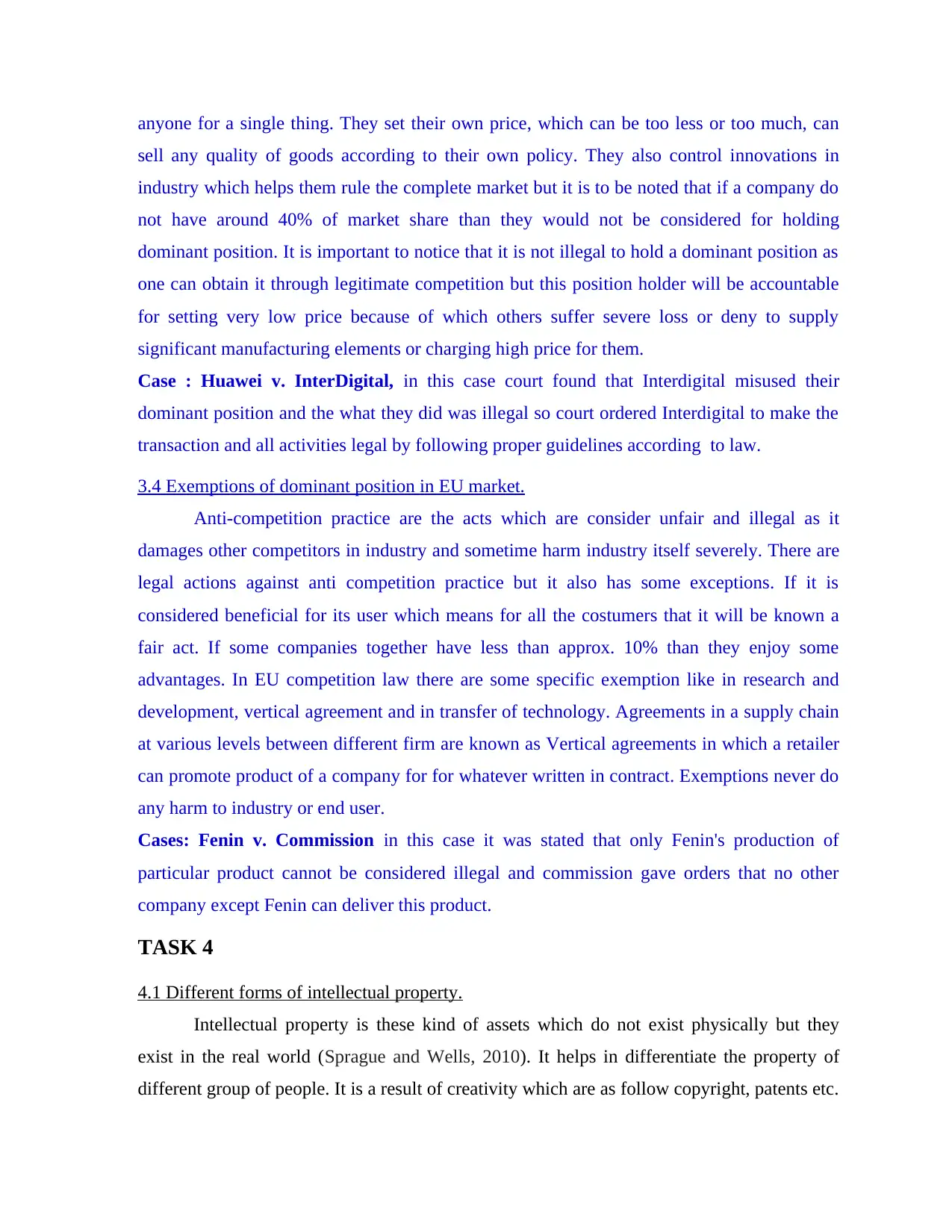
anyone for a single thing. They set their own price, which can be too less or too much, can
sell any quality of goods according to their own policy. They also control innovations in
industry which helps them rule the complete market but it is to be noted that if a company do
not have around 40% of market share than they would not be considered for holding
dominant position. It is important to notice that it is not illegal to hold a dominant position as
one can obtain it through legitimate competition but this position holder will be accountable
for setting very low price because of which others suffer severe loss or deny to supply
significant manufacturing elements or charging high price for them.
Case : Huawei v. InterDigital, in this case court found that Interdigital misused their
dominant position and the what they did was illegal so court ordered Interdigital to make the
transaction and all activities legal by following proper guidelines according to law.
3.4 Exemptions of dominant position in EU market.
Anti-competition practice are the acts which are consider unfair and illegal as it
damages other competitors in industry and sometime harm industry itself severely. There are
legal actions against anti competition practice but it also has some exceptions. If it is
considered beneficial for its user which means for all the costumers that it will be known a
fair act. If some companies together have less than approx. 10% than they enjoy some
advantages. In EU competition law there are some specific exemption like in research and
development, vertical agreement and in transfer of technology. Agreements in a supply chain
at various levels between different firm are known as Vertical agreements in which a retailer
can promote product of a company for for whatever written in contract. Exemptions never do
any harm to industry or end user.
Cases: Fenin v. Commission in this case it was stated that only Fenin's production of
particular product cannot be considered illegal and commission gave orders that no other
company except Fenin can deliver this product.
TASK 4
4.1 Different forms of intellectual property.
Intellectual property is these kind of assets which do not exist physically but they
exist in the real world (Sprague and Wells, 2010). It helps in differentiate the property of
different group of people. It is a result of creativity which are as follow copyright, patents etc.
sell any quality of goods according to their own policy. They also control innovations in
industry which helps them rule the complete market but it is to be noted that if a company do
not have around 40% of market share than they would not be considered for holding
dominant position. It is important to notice that it is not illegal to hold a dominant position as
one can obtain it through legitimate competition but this position holder will be accountable
for setting very low price because of which others suffer severe loss or deny to supply
significant manufacturing elements or charging high price for them.
Case : Huawei v. InterDigital, in this case court found that Interdigital misused their
dominant position and the what they did was illegal so court ordered Interdigital to make the
transaction and all activities legal by following proper guidelines according to law.
3.4 Exemptions of dominant position in EU market.
Anti-competition practice are the acts which are consider unfair and illegal as it
damages other competitors in industry and sometime harm industry itself severely. There are
legal actions against anti competition practice but it also has some exceptions. If it is
considered beneficial for its user which means for all the costumers that it will be known a
fair act. If some companies together have less than approx. 10% than they enjoy some
advantages. In EU competition law there are some specific exemption like in research and
development, vertical agreement and in transfer of technology. Agreements in a supply chain
at various levels between different firm are known as Vertical agreements in which a retailer
can promote product of a company for for whatever written in contract. Exemptions never do
any harm to industry or end user.
Cases: Fenin v. Commission in this case it was stated that only Fenin's production of
particular product cannot be considered illegal and commission gave orders that no other
company except Fenin can deliver this product.
TASK 4
4.1 Different forms of intellectual property.
Intellectual property is these kind of assets which do not exist physically but they
exist in the real world (Sprague and Wells, 2010). It helps in differentiate the property of
different group of people. It is a result of creativity which are as follow copyright, patents etc.
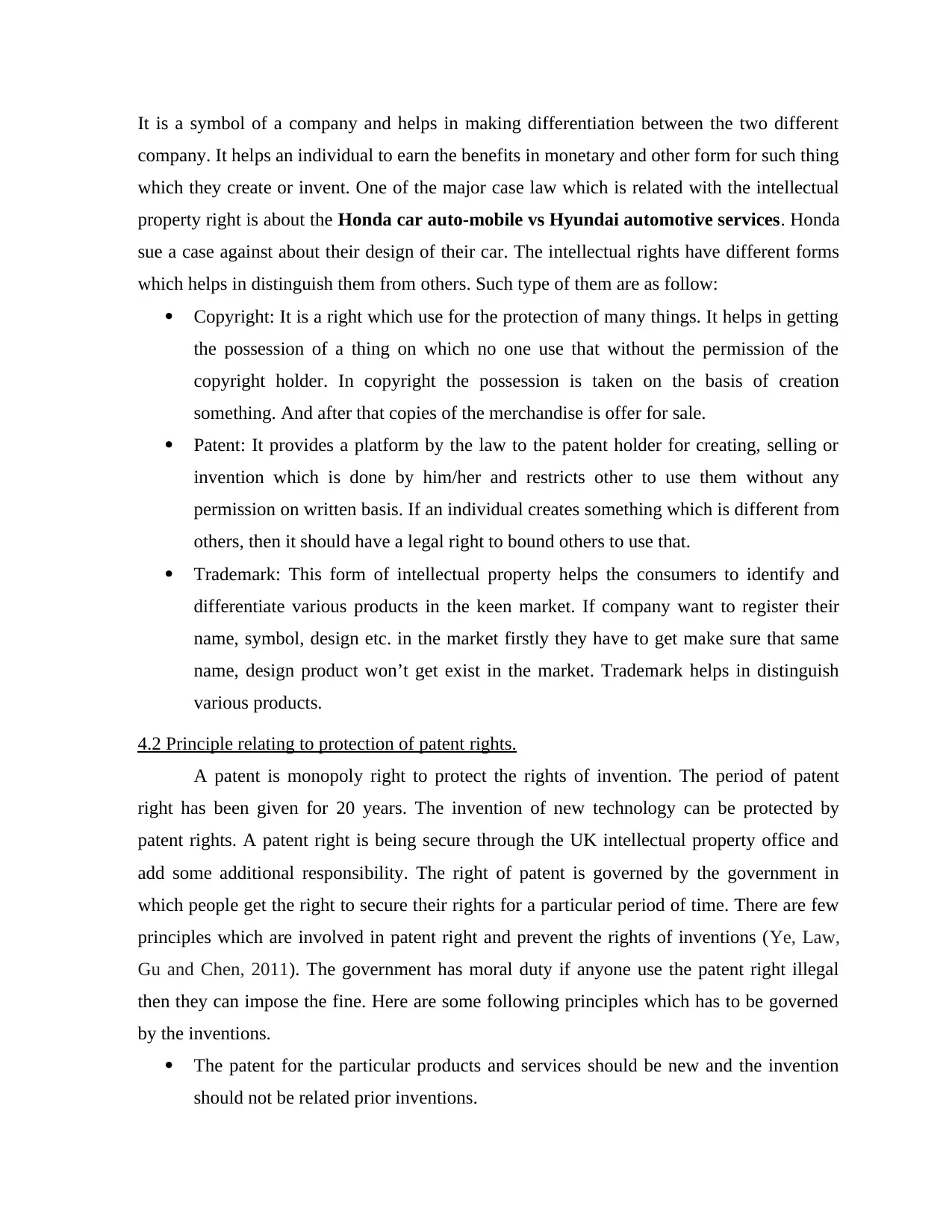
It is a symbol of a company and helps in making differentiation between the two different
company. It helps an individual to earn the benefits in monetary and other form for such thing
which they create or invent. One of the major case law which is related with the intellectual
property right is about the Honda car auto-mobile vs Hyundai automotive services. Honda
sue a case against about their design of their car. The intellectual rights have different forms
which helps in distinguish them from others. Such type of them are as follow:
Copyright: It is a right which use for the protection of many things. It helps in getting
the possession of a thing on which no one use that without the permission of the
copyright holder. In copyright the possession is taken on the basis of creation
something. And after that copies of the merchandise is offer for sale.
Patent: It provides a platform by the law to the patent holder for creating, selling or
invention which is done by him/her and restricts other to use them without any
permission on written basis. If an individual creates something which is different from
others, then it should have a legal right to bound others to use that.
Trademark: This form of intellectual property helps the consumers to identify and
differentiate various products in the keen market. If company want to register their
name, symbol, design etc. in the market firstly they have to get make sure that same
name, design product won’t get exist in the market. Trademark helps in distinguish
various products.
4.2 Principle relating to protection of patent rights.
A patent is monopoly right to protect the rights of invention. The period of patent
right has been given for 20 years. The invention of new technology can be protected by
patent rights. A patent right is being secure through the UK intellectual property office and
add some additional responsibility. The right of patent is governed by the government in
which people get the right to secure their rights for a particular period of time. There are few
principles which are involved in patent right and prevent the rights of inventions (Ye, Law,
Gu and Chen, 2011). The government has moral duty if anyone use the patent right illegal
then they can impose the fine. Here are some following principles which has to be governed
by the inventions.
The patent for the particular products and services should be new and the invention
should not be related prior inventions.
company. It helps an individual to earn the benefits in monetary and other form for such thing
which they create or invent. One of the major case law which is related with the intellectual
property right is about the Honda car auto-mobile vs Hyundai automotive services. Honda
sue a case against about their design of their car. The intellectual rights have different forms
which helps in distinguish them from others. Such type of them are as follow:
Copyright: It is a right which use for the protection of many things. It helps in getting
the possession of a thing on which no one use that without the permission of the
copyright holder. In copyright the possession is taken on the basis of creation
something. And after that copies of the merchandise is offer for sale.
Patent: It provides a platform by the law to the patent holder for creating, selling or
invention which is done by him/her and restricts other to use them without any
permission on written basis. If an individual creates something which is different from
others, then it should have a legal right to bound others to use that.
Trademark: This form of intellectual property helps the consumers to identify and
differentiate various products in the keen market. If company want to register their
name, symbol, design etc. in the market firstly they have to get make sure that same
name, design product won’t get exist in the market. Trademark helps in distinguish
various products.
4.2 Principle relating to protection of patent rights.
A patent is monopoly right to protect the rights of invention. The period of patent
right has been given for 20 years. The invention of new technology can be protected by
patent rights. A patent right is being secure through the UK intellectual property office and
add some additional responsibility. The right of patent is governed by the government in
which people get the right to secure their rights for a particular period of time. There are few
principles which are involved in patent right and prevent the rights of inventions (Ye, Law,
Gu and Chen, 2011). The government has moral duty if anyone use the patent right illegal
then they can impose the fine. Here are some following principles which has to be governed
by the inventions.
The patent for the particular products and services should be new and the invention
should not be related prior inventions.
⊘ This is a preview!⊘
Do you want full access?
Subscribe today to unlock all pages.

Trusted by 1+ million students worldwide
1 out of 17
Related Documents
Your All-in-One AI-Powered Toolkit for Academic Success.
+13062052269
info@desklib.com
Available 24*7 on WhatsApp / Email
![[object Object]](/_next/static/media/star-bottom.7253800d.svg)
Unlock your academic potential
Copyright © 2020–2025 A2Z Services. All Rights Reserved. Developed and managed by ZUCOL.





